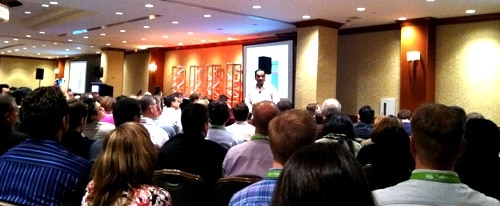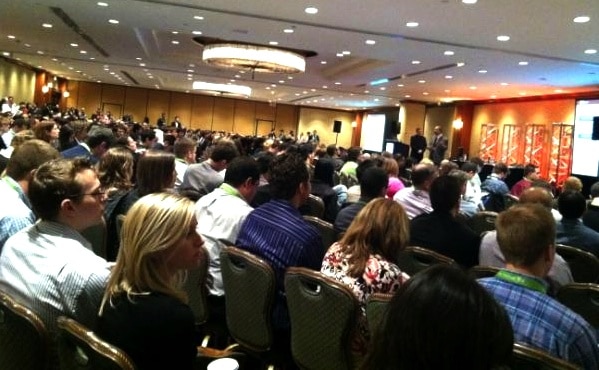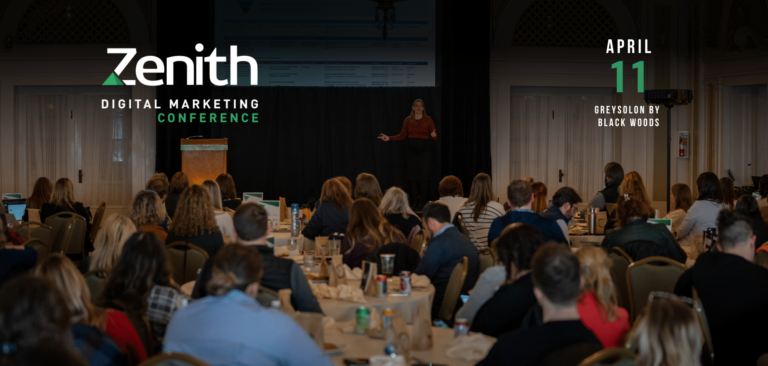Welcome to AIMCLEAR‘s coverage of Search Engine Strategies, New York edition! Ahhhh, Avinash. Nothing says “Let’s do this, #SES!” like an opening keynote from a super-smart and borderline racy marketer the likes of Avinash Kashuk, Digital Marketing Evangelist at Google. “Borderline racy” a little too vague for the readers at home? Previous Avinash keynotes tackled tantalizing topics such as making sweet, sweet love to search engines by way of keywords that really matter, among other things…
This go-round, on the morning of Day 1 at SES New York, Avinash charged up the packed room of attendees with talk about search, more specifically the zen of incorporating multiple media channels, including social, email, display, video– the works. But of course, activity across these mediums means little without a keen focus on metrics. Which is why Avinash shared rockstar tips for leveraging wicked cool analytics and bodacious benchmarks. Bliss! AIMCLEAR live-tweeted this killer keynote via @beebow. Read on for the top-shelf takeaways.
After a hearty welcome by Mike Grehan, who noted that words like “guru” should pretty much never be used outside the rare situation where the person in question actually is a freakin’ brilliant guru, Avinash Kashuk the freakin’ brilliant guru took the stage. The room was packed to the gills, and with good reason.
“Information is powerful.”
It was with this simple but significant quote that Avinash began his presentation. After thoughtful reflection, he unveiled the second half of the quotation: “But it is how we use it that will define us.” This was undoubtedly the theme of Avinash’s opening keynote at #SESNY. As online marketers, data, metrics, and analytics are our information… and they are powerful. But it is how we leverage the data that shapes us as marketers, makes us successful or mediocre.
Throughout his presentation, Avinash aimed to tell us his perspective on how to do a lot more to what information we have access to— because it’s not just about knowing what to do (what analytics to track), but knowing how to scale it
Influence + Experience + Value
Avinash is insanely passionate about the intersection between influence, experience, and value (in other words: marketing, magic, and money). Our job as marketers is to find the right people to influence and then delivering an “enormously awesome” experience to them.
Did You Know: The average conversion rate of even the best sites out there is 2%. TWO PERCENT! Sheesh. Most marketers hyper-optimize for that 2%, on the macroconversions. But this is a totally counter-intuitive approach– it causes you to completely miss out on the bigger picture. It handicaps your company from thinking for the broad scale.
Steamy Sexy Analogy #1: The 2% of macro conversions are like the people who jump into bed with you right away. The 98% is everyone else, and they’re the glaring majority. Not everyone wants to jump in bed with you (buy from you, convert) right away – that’s just how it is. But you better believe there is something you can extract from them learn from spending time with them… something that can perhaps increase the chances of them jumping into bed with you two weeks later.
Focus on macroconversions AND microconversions. Focus on immediate revenue AND everything that leads up to it, or helps contribute to it in one way or another. Your salary shouldn’t be dependent upon the 2% – it should be about the overall economic value you provide.
Things to Measure:
- Cute Kids Stuff: Clicks, Average CPC, Cost per Action
- Hip Teenager Stuff: … Conversions, Revenue, Revenue Per Action
- Ultimate Killer Master Ninja Stuff: Economic Value Per Acquisition
We all invest in different facets of online marketing – social, search, display, email, etc. Not everything translates to macroconversions. Maybe in contrast to email, which represents a bulk of conversions, display, search, and social drive microconversions. Don’t you dare ignore the sources of microconversions! They deserve your attention.
Takeaway: Balance for short and long term – optimize not just for revenue, but for economic value.
Intelligent Attribution Modeling
Avinash shared a two-step approach to optimizing our digital marketing budget:
- Understand your current performance.
- Apply optimal attribution model.
Let’s tackle the first step first. Understanding your current performance. Do what most people don’t do nearly often enough: Log into analytics. Pepare to dig deep. But first, understand that your digital campaigns don’t live in individual silos. They are all integrated.
“Don’t go party tonight,” Avinash suggests. “Go to your hotel room, log into analytics, and dig deep.” Go crazy. Get intimate. Spice things up with source / medium paths and tracking conversions. Then, take all that juicy goodness spilling out from Analytics and make it sexy.
How?
Data visualization tools. Avinash uses super sexy streamgraphs to help visualize the tens of thousands of lines of data pulled from Analytics. Data visualizations help your brain understand channels, traffic sources, keywords that matter – how they trend (up or down?) and other essential metrics. Go to http://Zqi.me/vizd3 for more sexiness. Avinash recommends Sunburst Diagrams and Chord Diagrams. They seem to make him drool the most.
Interesting Anecdote: After Avinash saw such data visualizations for the first time, he called his wife and said, “I just had an orgasm at work… and nobody else was involved!”
Mashup data on searches and conversion. Glean: Are you having one nights stands? Or do you have to go on 3-4 dates before someone converts? Say your analytics tells you it takes multiple searches for people to convert – what does their behavior look like? Digging deep into analytics can tell you, for example, that very generic KWs are the original KW touch points for users. Maybe data shows you the top types of KWs are generic, then brand-specific. Perhaps those two clusters of KWs represent 24% of conversions! If you didn’t do the work to arrive at that figure, and preemptively hacked out those clusters, you’d lose out massively.
Bottom line: Pulling data from Analytics isn’t hard. Plugging it into killer data visualization tools isn’t hard. So there’s no reason you shouldn’t be doing it! And then…
Onto step 2: Applying Optimal Attribution Model.
- A typical attribution model awards all credit to the last click. But that’s not entirely fair. What about the originating source that propelled a user towards conversion?
- Enter stage right, a variation on this model that awards all credit to the first click. But hang on, that doesn’t make sense, either. “That’s like me giving my first girlfriend all the credit for me marrying my wife,” as Avinash put it.
- Yet another phase of this attribution model is to award equal credit to all touch points. Swooping in with another clever analogy, Avinash recalls his seven-year-old son’s recreational sports team– how every player for a “Certificate of Participation.” Realistically, that’s crap – because not every kid participated, and some participated a lot more than others. Thus – this model is also inadequate.
- Onto another phase of the attribution model, this one focusing on time decay / delay, which awards increasing credit over time– higher credit for closer proximity to last touch.
- (Another attribution model is one that’s personalized to your business – but Avinash warns to at least be wary of this path. It might be the right solution for your company, but carries a “MCU” factor (make crap up). Don’t make crap up. Period.
Avinash’s Strategy to Proper Attribution: Constant flow from Measure –> Value –> Test, and then back to Measure.
Avinash’s Advice For Doing The Best You Can Possibly Do When It Comes To Participating in Multiple Channels:
- Understand
- Test
- Be Less Wrong
Shifting Away From The Shouting World
Increasingly, we’re moving away from Traditional Marketing on channels where all we did was shout into channels where we can do much more. Think about television, radio, newspapers, magazines – all marketers can do when they advertise on these channels is SHOUT at whomever may be on the other end – and really, they don’t even know who is on the other end (or what they’re doing). Insight from companies like Nielsen can help, but not nearly to degree we need in order to be effective.
The shift is happening from Traditional Marketing to Internet Marketing. It’s amazing to be able to create an ad and tailor it who will be seeing it, and where they will be seeing it as they travel across the web. As Avinash said, Â “It’s magical not to see crap!”
The shift will continue to happen from Internet Marketing to the Social Web Revolution. This shift is slow, it’s gradual. But the thing that is guaranteed is that the age of SHOUT marketing is dead.
Measuring What Matters with Social
So much of social today is about really basic metrics, such as… how many Followers do we have? How many times did we tweet today? What time did we tweet? To this, Avinash asks, “Who gives a sh*t?”
It’s essential to ground your understanding in the “So What?” of these metrics. Your branded Twitter profile has 5,392 followers. So what?! What are you DOING with those followers? Who are the ones that matter? Who is doing what you want them to do? What’s the economic value of time spent in social channels? It’s not about tweets per day. It’s about conversions and their social sources.
Kids measure tweets per day. Killer master ninjas measure conversions, assisted social conversions, and last interaction social conversion all in a context of social sources. This data can help you calculate the monetary value of a fan. That’s right. How much money a fan is worth. Now THAT’S data worth bringing to the boss.
Data leaves no room for debate of the value of a Like, or a Fan, or a Follower.
Social media is not based on faith anymore. You shouldn’t do social because you have faith it will be benefit your company. You should do social because it delivers economic value to your business. And the only way to discover whether it does or not is by looking at the data and drawing conclusions from it.
Avinash encourages marketers push beyond the “So What?” and into the “Where?” He wants us to understand where activity is coming from, and where it’s happening. This could very well be off-site. Don’t obsess what’s happening on your site- focus on what’s happening on social channels that’s causing the economic value. Dive into Google Analytics – study originating social networks, social sources, overall and social traffic, and ACTION!
We’re not through digging yet. Push beyond the “So What?”, beyond the “Where?” and into the “Why?” Why are conversions happening? Why is value being created? Precisely focus – hone in on the data surrounding individual pieces of content you share – indivisual people you connect with (or connect with you). Be able to sit back and say, “When we do X, it causes more RTs. When we do Y, we get more Likes.” Crack the code, then get to work.
Understanding this data can help advise your social media strategy, where you spend your time, and most importantly, how you spend your time (what content you share, how much you engage, how you engage, etc.).
The Social Side of Google Analytics
Breaking News! Starting today, and rolling out in the coming weeks, a new Social Measurement section has been added to Google Analytics. Be sure to scope it out, play around, and get familiar with what it has to offer.
Final Words of Advice
Life is about constantly experimenting. If 10% of your budget is not being used to fail faster, it’s impossible for you to identify the disruptive trends that will destroy your business. “Fail forward, fail faster,” as Avinash put it. In other words: Test, test, test constantly so you can uncover problems immediately and fix them just as fast. Furthermore, rather than obsess about technologies, obsess about digital outcomes for your business.
5 Things To Do Now & Ongoing (High-Level Takeaways)
- Focus on measuring holistic success.
- Be less wrong over time. Understand, test, learn.
- Rethink social. Dig into the So what?, Where?, and Why? .
- Stop guessing. Use controlled experiments.
- Have insane focus. Have a clear line of sight.
And with that, Avinash wrapped up and the crowd went wild. Must have been all that talk about “The Big O” and sexy data graphs. Can you dig it? 🙂
Stick around for more coverage of #SESNY 2012 right here in AIMCLEAR blog. And remember – if you catch one of us wandering around the conference halls or cruising through the expo hall, stop us and say hi! We don’t bite. Hard.











